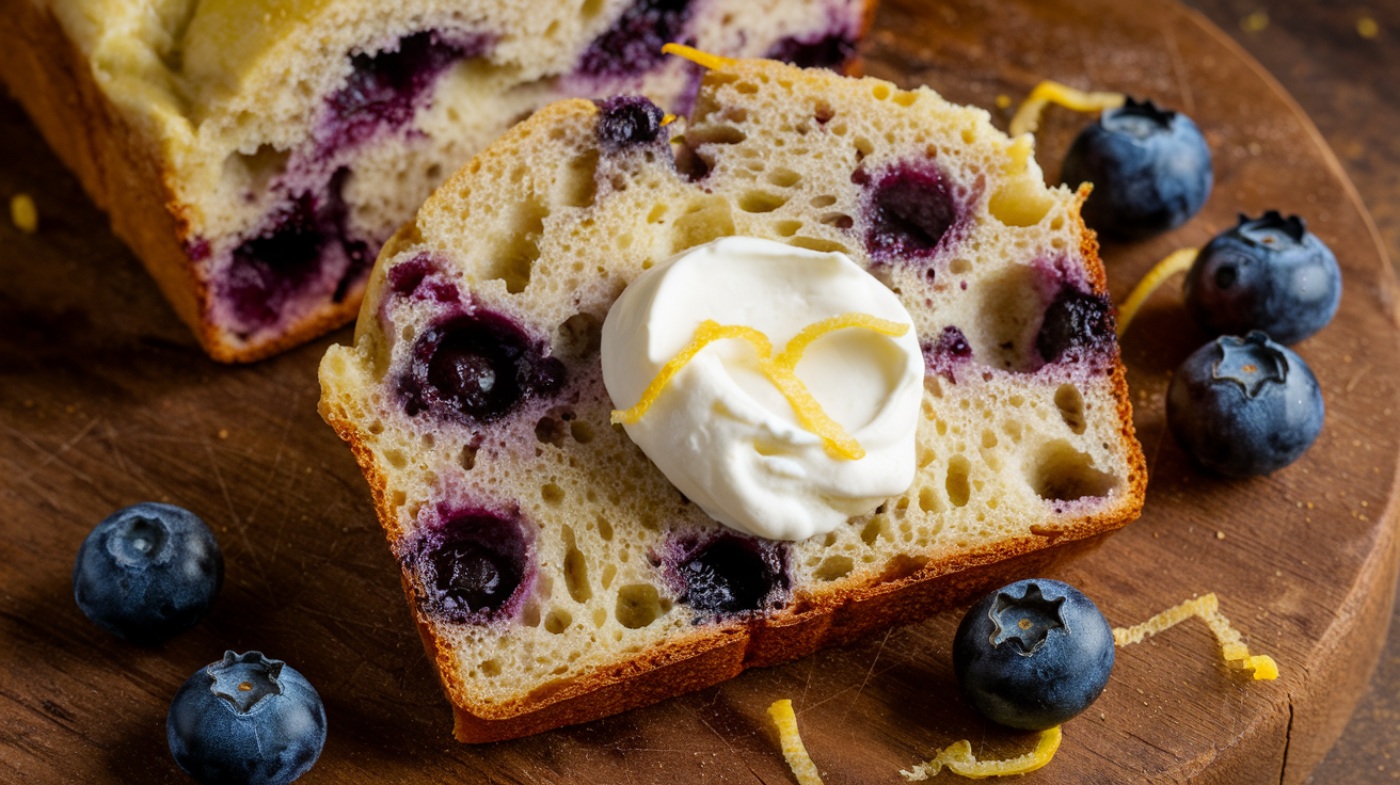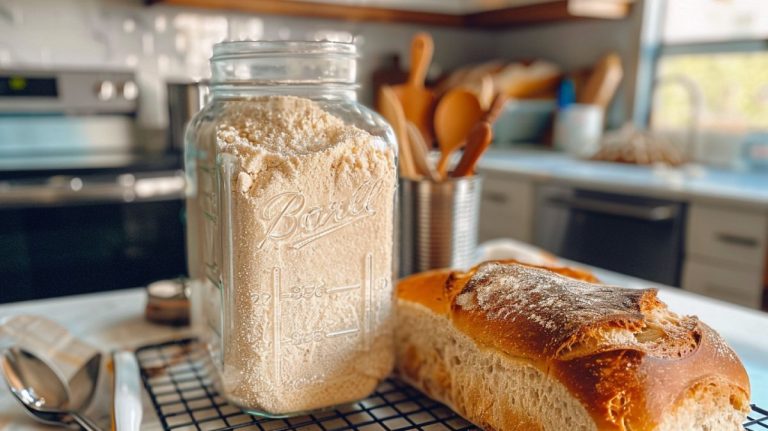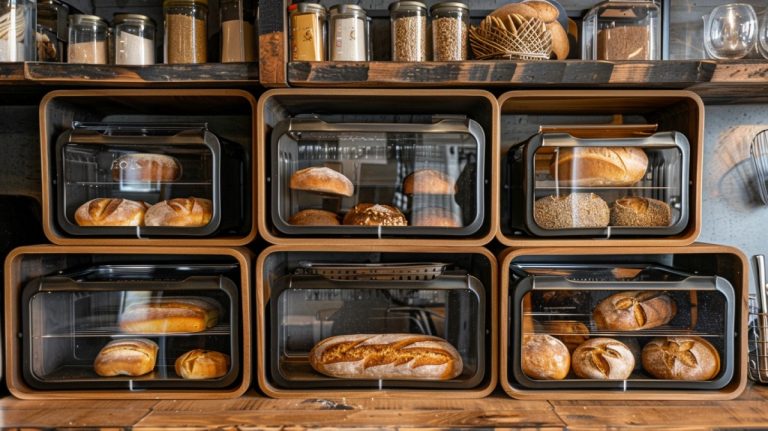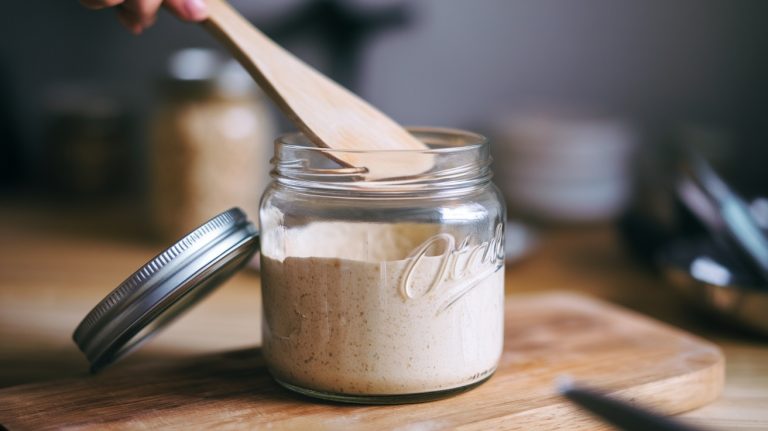Blueberry Lemon Sourdough Bread Recipe: A Taste of Bliss
To make delicious Blueberry Lemon Sourdough Bread, start by activating your sourdough starter. Mix bread flour with water, salt, and a zesty combination of lemon juice and zest.
Once combined, gently incorporate fresh blueberries to keep them intact. Let the dough rest and perform a few stretch-and-folds to develop elasticity.
Shape your dough, then bake in a preheated Dutch oven for a crusty finish. This vibrant bread’s tangy flavors are a delight—keep going to enhance your baking skills.
Key Takeaways
- Combine 500g bread flour, 100g active sourdough starter, 350g water, and 10g salt in a mixing bowl for dough preparation.
- Incorporate 100-148g fresh blueberries and zest of one lemon during the final stages of dough development to enhance flavor.
- Allow the dough to rest for 30 minutes to an hour in the autolyse process for optimal gluten development.
- Shape the dough gently, placing it seam side up in a banneton for proofing before baking.
- Bake in a preheated Dutch oven at 450°F (230°C) for 20-30 minutes covered, then 10-15 minutes uncovered until golden brown.
Ingredients Needed for Blueberry Lemon Sourdough Bread
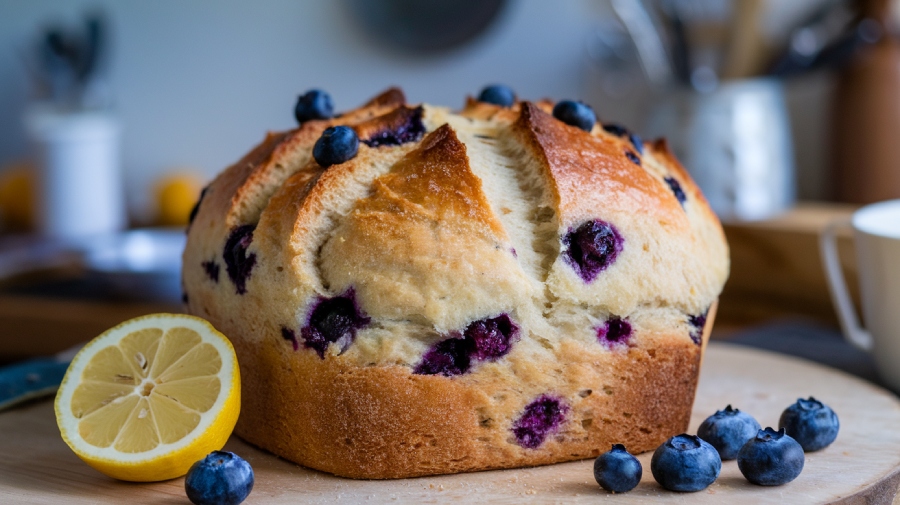
To commence your journey of making delicious blueberry lemon sourdough bread, you’ll need a handful of essential ingredients that come together to create a delightful flavor profile.
Start with bread flour, which provides structure and absorbs water beautifully. Your active sourdough starter, bubbly and ready, is vital for fermentation. Don’t forget water—tap or filtered—for hydration. A pinch of salt enhances flavor and controls yeast growth. For that sweet touch, consider adding sugar or honey.
Next, bring in the flavor! Lemon zest and juice will brighten up your bread, while fresh blueberries contribute sweetness and texture. The combination of unique flavor profile from the tangy sourdough, sweet blueberries, and zesty lemon creates a bread that truly intrigues the taste buds. Maintaining a consistent dough temperature during mixing is crucial for optimal yeast performance and achieving the perfect rise.
Optional ingredients like rice flour for dusting or dried blueberries for a punchy flavor can elevate your loaf.
Activating Your Sourdough Starter
Activating your sourdough starter is essential for achieving that perfect rise and tangy flavor in your blueberry lemon bread. By following a consistent feeding schedule, you can guarantee your starter is bubbly and ready to work its magic in just a few hours. Regular feeding is crucial for maintaining starter health, ensuring it remains active and effective for baking. A well-fed starter can significantly enhance the fermentation process in your dough, leading to a more flavorful loaf.
Importance of Active Starter
When it comes to baking exceptional sourdough bread, the importance of an active starter can’t be overstated. Your starter’s microbial composition, rich in yeast and lactic acid bacteria, is what gives your bread its rise and distinctive flavor.
An active starter efficiently leavens your dough, creating that light, airy texture you crave. As yeast converts sugars into carbon dioxide, it fills your dough with bubbles, while lactic acid bacteria produce the tangy sourness that beautifully balances the sweetness of blueberries and the zest of lemons. Using your starter at its peak activity ensures maximum fermentation and rise, allowing your bread to reach its full potential. A well-fed starter that has been maintained consistently will demonstrate optimal performance, further enhancing your baking results.
Feeding Schedule Tips
Keeping your sourdough starter lively is a key step in guaranteeing your bread turns out beautifully. Your feeding schedule will depend on the temperature and your baking needs. Here’s a simple guide to help you:
| Temperature | Feeding Frequency |
|---|---|
| 70-75°F (21-24°C) | Daily |
| 76°F (24°C) | Every 12 hours |
| Refrigerated | Weekly or bi-weekly |
| Warm Environment | Twice-daily |
Mixing the Dough
Mixing the dough might seem straightforward, but it’s an important step that sets the foundation for your Blueberry Lemon Sourdough Bread.
Start by adding water first to prevent excess flour and guarantee easy adjustments. Dissolve the salt in the water for even distribution—this helps with gluten development. Precision in increments can influence dough hydration and fermentation, making accurate readings essential for achieving desired sourdough results.
Pre-blend your flours to cut down on mixing time, achieving a consistent porridgy texture that allows for better incorporation of your sourdough culture. Use your hands or a Danish dough whisk to mix gently, maintaining control over the dough’s consistency. A unique mixing technique emphasizes simplicity and efficiency while minimizing kitchen time.
Don’t forget to let the dough rest—this hydrates the flour and enhances gluten strength. Keep an eye on the temperature, as it plays a vital role in fermentation.
Incorporating Blueberries and Lemon
To achieve the perfect balance of flavors in your Blueberry Lemon Sourdough Bread, you’ll want to incorporate the blueberries and lemon at just the right moment.
Start with fresh blueberries for the best texture and flavor—aim for around 100g to 148g per loaf. Mix them in towards the end of your dough development to prevent gummy spots. Using high protein flour can enhance the overall structure of your bread, contributing to a better rise.
For the lemon, use about 20 grams of fresh juice and the zest of one lemon to elevate the citrus notes. Combining the zest with sugar helps release essential oils, intensifying the flavor. Additionally, this artisan sourdough bread recipe has been refined through extensive testing to ensure the best results.
Adjust your water content slightly to accommodate the blueberries, ensuring a perfect dough consistency.
Resting and Folding Techniques
Resting and folding are essential steps in crafting that perfect blueberry lemon sourdough bread. When you allow the dough to rest, you’re giving those gluten strands a chance to relax, leading to a better structure and oven spring. Relaxed gluten aids in achieving a more pronounced rise during baking. Combine this with the stretch and fold technique, and you’ll enhance gluten development, resulting in a beautifully airy crumb. Additionally, maintaining an optimal dough temperature of 74 to 78°F is crucial for yeast and bacterial activity, ensuring a successful fermentation process.
Importance of Resting Periods
When you give your dough a break, you’re not just stepping away; you’re allowing enzymatic activity to work its magic, enhancing gluten development without the need for excessive kneading. This initial resting period, called autolyse, typically lasts 30 minutes to an hour, and it’s crucial for creating a complex flavor in your bread. During this time, wet ingredients absorb the flour evenly, preventing any overworking of the dough.
A well-rested dough is easier to shape and handle later on, and it leads to a stronger gluten structure essential for good bread. Preheating the Dutch oven before baking also plays a vital role in ensuring that your blueberry lemon sourdough turns out deliciously airy and flavorful, as it allows for further development of texture and taste. Plus, that final proofing rest before baking helps achieve the perfect rise and texture, ensuring your blueberry lemon sourdough turns out deliciously airy and flavorful.
Stretch and Fold Technique
The stretch and fold technique revolutionizes how you develop gluten in your sourdough, allowing for a strong, airy crumb without the need for vigorous kneading. This method enhances dough structure by activating gluten through gentle stretches and folds, making it a preferred choice for high-hydration doughs. You can apply it in the bowl or on the countertop for convenience. During this process, it is essential to complete five stretch and folds for optimal results.
| Step | Description |
|---|---|
| Initial Stretch | Stretch dough upward with wet hands. |
| Folding Technique | Fold back over the center of the dough mass. |
| Rotate Bowl | Rotate a quarter turn after each fold. |
| Rest Between Sets | Allow 15 to 60 minutes for relaxation. |
| Total Sets | Perform 3 to 5 sets based on dough response. |
This technique improves elasticity and leads to a higher rise with a more open crumb.
Gluten Development Process
Understanding the gluten development process is essential for achieving the perfect sourdough bread texture. Start with an initial rest to hydrate your flour, which kickstarts gluten formation and strengthens your dough. Depending on your flour type and the temperature, resting times can range from minutes to hours. If you’re using high-protein flour, keep those rests shorter to prevent over-development.
Remember, warmer temperatures speed up gluten formation, so adjust your timing accordingly. Incorporate folding techniques, like stretch and folds, during resting periods to enhance gluten structure. High hydration is recommended for optimal gluten development, ensuring your dough achieves the right texture. Additionally, proper hydration levels are crucial for successful baking, as they significantly influence gluten strength and dough texture.
Shaping the Dough
Shaping the dough is an essential step that transforms your well-developed mixture into a beautiful loaf.
Begin by gently folding the dough like an envelope, bringing the bottom and top flaps toward the center. This technique builds tension and gives your loaf structure. Stretch and fold technique is also recommended to enhance the dough’s strength during this process.
Next, roll the dough neatly to maintain symmetry, ensuring a taut surface. As you incorporate blueberries, handle them with care to prevent bursting; distribute them evenly for that delightful burst of flavor.
Place your shaped dough seam side up in a banneton or floured bowl to keep its form during proofing. Cover it to retain humidity, setting the stage for a delicious rise before baking.
Baking the Bread
After your dough has risen beautifully in the banneton, it’s time to bring it to life in the oven. Preheat your oven to 450°F (230°C) and let your Dutch oven warm up for at least 45 minutes. Carefully score the dough with a bread lame, then place it in the hot vessel. Bake with the lid on for 20-30 minutes to achieve that crispy crust. After removing the lid, continue baking for another 10-15 minutes until the crust turns golden brown. Remember, using a heavy cast iron Dutch oven is essential for achieving the perfect baking results.
| Step | Duration | Tips |
|---|---|---|
| Lid-On Baking | 20-30 minutes | Confirm internal temp is 205-210°F |
| Uncovered Baking | 10-15 minutes | Look for a golden brown crust |
| Cooling | At least 2 hours | Use a wire rack for best results |
Flavor Variations and Serving Suggestions
As you explore the delightful world of flavor variations and serving suggestions for your blueberry lemon sourdough bread, you’ll discover countless ways to elevate its taste and presentation.

Adjust the lemon zest or juice to match your preferred tanginess, and consider using dried blueberries for a chewy texture. For a sweet twist, try adding maple syrup or brown sugar to the dough. Baking this bread with fresh blueberries enhances the overall flavor profile, making it an irresistible treat.
Adjust the lemon zest or juice for your ideal tanginess, and try dried blueberries for an added chewy texture.
Serve it warm with high-quality butter, or whip up some blueberry honey butter for a delightful spread. Lemon curd enhances both flavor and sweetness, making it perfect for afternoon tea.
You can even transform slices into French toast or use them in breakfast bowls for a nutritious start to your day.
Tips for Perfecting Your Sourdough Bread
To achieve the perfect blueberry lemon sourdough bread, it’s crucial to start with a well-maintained sourdough starter. Feed it regularly and use it at its peak for ideal rise.
When preparing your dough, sift flour to reduce denseness and pre-soak whole grains for a lighter texture. Remember to handle the dough gently to preserve air pockets, and use the stretch and fold technique during bulk rise. Be gentle with your dough to prevent gas loss, ensuring a lighter final product.
For proofing, choose a cloth-lined basket and flour it generously to prevent sticking. Score your dough just before baking for a controlled rise.
Finally, preheat your oven to a high temperature, and consider using a Dutch oven for a beautifully crusty finish. Monitor the internal temperature for perfect doneness.
Frequently Asked Questions
Can I Use Frozen Blueberries Instead of Fresh Ones?
Absolutely, you can use frozen blueberries instead of fresh ones! They’re convenient and can be stored for longer periods without spoiling.
Just keep in mind that frozen blueberries may release more moisture, so you might need to adjust your recipe slightly. There’s no need to thaw them; you can toss them directly into your batter.
For best results, coat them in flour to prevent sinking and color bleeding during baking. Enjoy your delicious creation!
How Long Can I Store the Baked Bread?
You can store your baked bread at room temperature for about 4-5 days, depending on humidity and how hydrated the loaf is.
For best results, use a bread box or wrap it in a cloth to regulate airflow. Avoid refrigeration, as it dries out the bread faster.
If you want to keep it longer, freezing is a great option—just remember to wrap it properly to prevent freezer burn!
What if My Sourdough Starter Isn’t Bubbly?
If your sourdough starter isn’t bubbly, don’t panic! Check its age; it might just need more time.
Make certain it’s in a warm spot, ideally around 74-76°F.
Review your feeding schedule; inadequate feeding can hinder activity.
Experiment with different flour types, as some work better than others.
Finally, observe for any rise and fall—this can indicate fermentation progress.
Adjusting these factors can help bring your starter back to life!
Can I Substitute Whole Wheat Flour for Bread Flour?
Imagine trying to build a sturdy bridge with flexible reeds instead of strong steel. Substituting whole wheat flour for bread flour can feel similar.
While you can make the swap, it requires adjustments. Whole wheat flour absorbs more liquid and has a coarser texture, so increase your liquid and let the dough rest longer.
Using up to 50% whole wheat often yields tasty results without compromising structure, so experiment and enjoy the journey!
How Do I Know When the Bread Is Fully Baked?
To know when your bread’s fully baked, check for a golden-brown crust and a hollow sound when you knock on the bottom.
You can also use a thermometer; aim for an internal temperature of 205-210°F.
If you don’t have one, trust your senses—look for bubbles on the surface and listen for crackling sounds.
The bread should feel light and airy when lifted, ensuring that it’s perfectly baked and ready to enjoy!
Blueberry Lemon Bliss in Every Slice
Now that you’ve mastered the art of blueberry lemon sourdough bread, you’re just a whisk away from baking the best loaf that’ll ever grace your kitchen! The delightful burst of juicy blueberries paired with zesty lemon will elevate your baking to legendary status.
Don’t forget to share your creation with friends and family—they’ll be begging for your secret recipe! Keep experimenting and perfecting your craft, and soon you’ll be known as the sourdough superstar in your neighborhood.

